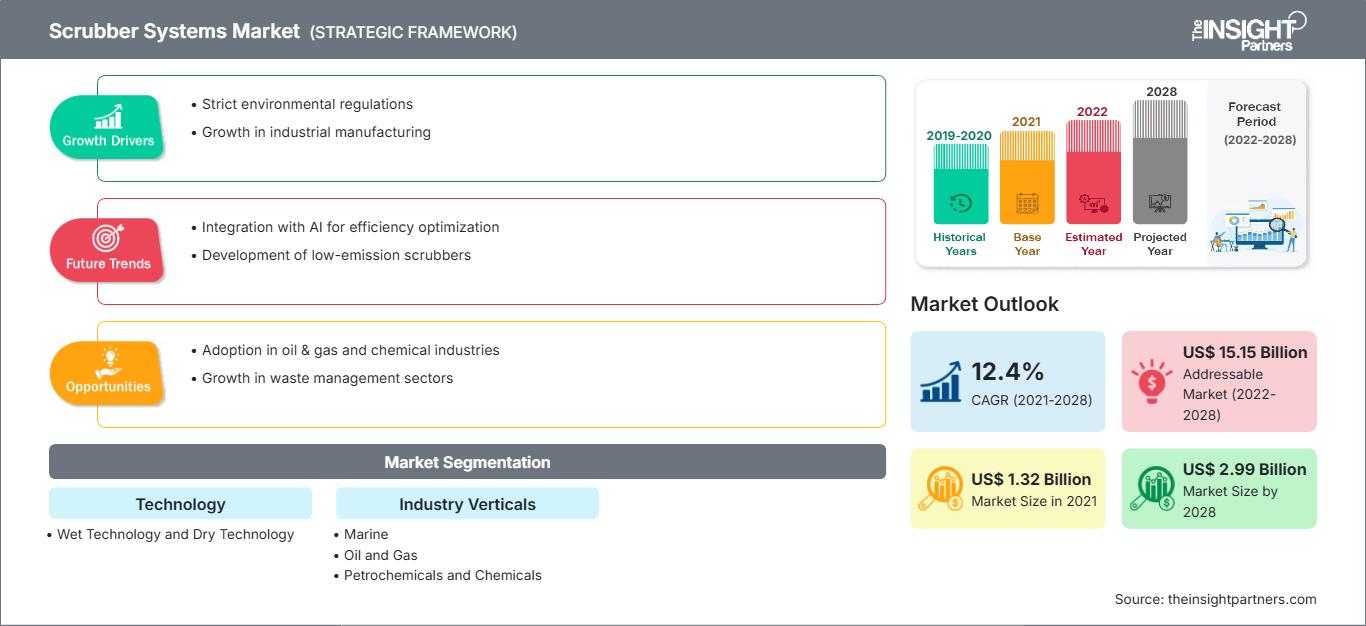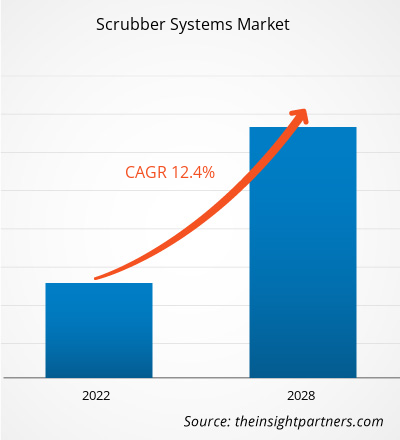Le marché des systèmes d'épuration était évalué à 1 316 millions de dollars américains en 2021 et devrait atteindre 2 989,2 millions de dollars américains d'ici 2028 ; il devrait croître à un TCAC de 12,4 % entre 2021 et 2028.
Les principales industries manufacturières telles que le ciment, le verre, la chimie et la pétrochimie, l'agroalimentaire et l'industrie pharmaceutique sont connues pour leurs émissions de gaz nocifs. Par conséquent, les réglementations environnementales strictes imposées à ces industries stimulent le marché. Par exemple, l'industrie du ciment est l'une des principales industries polluantes, car elle libère des particules de dioxyde d'azote (NO2) et de dioxyde de soufre (SO2) pendant la production. De plus, l'augmentation du commerce international par voie maritime et l'augmentation des activités de loisirs stimulent la croissance du marché des systèmes d'épuration. L'essor du transport maritime mondial peut être attribué à son coût de transport économique et à la demande mondiale en constante augmentation de biens et de produits pétroliers. De plus, la participation croissante aux activités de loisirs telles que les croisières et les voyages internationaux stimule l'utilisation des navires et alimente par conséquent la croissance du marché des systèmes d'épuration.
Impact de la pandémie de COVID-19 sur le marché des systèmes d'épuration
L'apparition soudaine de COVID-19 a eu un impact négatif significatif sur la demande pour l'industrie des systèmes d'épuration à la suite de la pandémie mondiale. En août 2020, Yara Marine Technologies, l'un des principaux acteurs du secteur des épurateurs marins, a détourné son attention du marché en raison de la COVID-19 et de la faiblesse des prix du pétrole. Le responsable de l'innovation de l'entreprise a déclaré qu'elle avait de grands espoirs en 2020 pour les systèmes d'épuration, mais que la COVID-19 avait tout changé. Cependant, le marché a connu une hausse de la demande à partir du troisième trimestre, plusieurs gouvernements ayant introduit des réglementations strictes pour maintenir la qualité de l'air. Les systèmes d’épuration d’air jouent un rôle essentiel dans l’élimination des particules dangereuses des gaz d’échappement, aidant ainsi le marché à retrouver son élan.
Personnalisez ce rapport en fonction de vos besoins
Vous bénéficierez d’une personnalisation sur n’importe quel rapport - gratuitement - y compris des parties de ce rapport, ou une analyse au niveau du pays, un pack de données Excel, ainsi que de profiter d’offres exceptionnelles et de réductions pour les start-ups et les universités
Marché des systèmes d'épuration: Perspectives stratégiques

- Obtenez les principales tendances clés du marché de ce rapport.Cet échantillon GRATUIT comprendra une analyse de données, allant des tendances du marché aux estimations et prévisions.
Perspectives du marché – Croissance du marché des systèmes d'épuration dans le commerce maritime mondial et les activités de loisirs
Vous bénéficierez d’une personnalisation sur n’importe quel rapport - gratuitement - y compris des parties de ce rapport, ou une analyse au niveau du pays, un pack de données Excel, ainsi que de profiter d’offres exceptionnelles et de réductions pour les start-ups et les universités
Marché des systèmes d'épuration: Perspectives stratégiques

- Obtenez les principales tendances clés du marché de ce rapport.Cet échantillon GRATUIT comprendra une analyse de données, allant des tendances du marché aux estimations et prévisions.
L'augmentation du commerce international par voie maritime et l'augmentation des activités de loisirs stimulent la croissance du marché des systèmes d'épuration. L'essor du commerce maritime mondial peut être attribué à son coût de transport économique et à la demande mondiale en constante augmentation de biens et de produits pétroliers. De plus, la participation croissante aux activités de loisirs telles que les croisières et les voyages internationaux augmente l'utilisation des navires et alimente ainsi la croissance du marché des systèmes d'épuration. L'essor des activités de loisirs peut être attribué à la hausse du revenu par habitant des consommateurs. Par conséquent, l'augmentation des émissions de soufre des navires, due à l'essor du commerce mondial, et l'intensification du transport maritime dans les économies en développement et développées, stimulent les installations de systèmes d'épuration.
Perspectives technologiques
Sur le plan technologique, le marché des systèmes d'épuration est segmenté en technologie humide et technologie sèche. Le segment des technologies humides a détenu une part de marché plus importante en 2021.
Les acteurs du marché des systèmes d'épuration se concentrent principalement sur le développement de produits avancés et performants.
- En juillet 2021, Babcock & Wilcox Environmental a annoncé son soutien à la demande de l'Amager Resource Center pour la construction d'une installation avancée de captage du dioxyde de carbone dans l'usine de valorisation énergétique des déchets d'ARC à Amager-Bakke (Copenhague) à Copenhague, au Danemark, pour un montant de plus de 140 millions de dollars américains.
- En septembre 2021, DuPont Clean Technologies a présenté une solution innovante et avancée de suppression du panache de vapeur pour ses épurateurs MECS DynaWave dans les unités de récupération du soufre (SRU). Sennuba assure un contrôle fiable de la corrosion et une suppression du panache dans le système d'épuration, avec un risque minimal de colmatage.
Aperçu régional du marché des systèmes d'épuration
Les tendances régionales et les facteurs influençant le marché des systèmes de lavage tout au long de la période de prévision ont été analysés en détail par les analystes de The Insight Partners. Cette section aborde également les segments et la géographie du marché des systèmes de lavage en Amérique du Nord, en Europe, en Asie-Pacifique, au Moyen-Orient et en Afrique, ainsi qu'en Amérique du Sud et en Amérique centrale.
Portée du rapport sur le marché des systèmes d'épuration
| Attribut de rapport | Détails |
|---|---|
| Taille du marché en 2021 | US$ 1.32 Billion |
| Taille du marché par 2028 | US$ 2.99 Billion |
| TCAC mondial (2021 - 2028) | 12.4% |
| Données historiques | 2019-2020 |
| Période de prévision | 2022-2028 |
| Segments couverts |
By Technologie
|
| Régions et pays couverts | Amérique du Nord
|
| Leaders du marché et profils d'entreprises clés |
|
Densité des acteurs du marché des systèmes de lavage : comprendre son impact sur la dynamique des entreprises
Le marché des systèmes d'épuration connaît une croissance rapide, porté par une demande croissante des utilisateurs finaux, due à des facteurs tels que l'évolution des préférences des consommateurs, les avancées technologiques et une meilleure connaissance des avantages du produit. Face à cette demande croissante, les entreprises élargissent leur offre, innovent pour répondre aux besoins des consommateurs et capitalisent sur les nouvelles tendances, ce qui alimente la croissance du marché.

- Obtenez le Marché des systèmes d'épuration Aperçu des principaux acteurs clés
- Analyse historique (2 ans), année de base, prévision (7 ans) avec TCAC
- Analyse PEST et SWOT
- Taille du marché Valeur / Volume - Mondial, Régional, Pays
- Industrie et paysage concurrentiel
- Ensemble de données Excel
Rapports récents
Témoignages
Raison d'acheter
- Prise de décision éclairée
- Compréhension de la dynamique du marché
- Analyse concurrentielle
- Connaissances clients
- Prévisions de marché
- Atténuation des risques
- Planification stratégique
- Justification des investissements
- Identification des marchés émergents
- Amélioration des stratégies marketing
- Amélioration de l'efficacité opérationnelle
- Alignement sur les tendances réglementaires




















 Obtenez un échantillon gratuit pour - Marché des systèmes d'épuration
Obtenez un échantillon gratuit pour - Marché des systèmes d'épuration